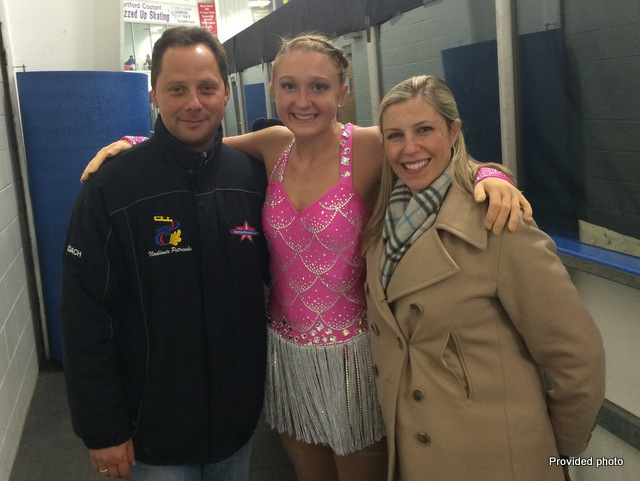Pittsfield Teen Follows Her Passion for Skating
|

Michaela Grady poses with coaches Vladimir Petrenko and Emilie Nussear.
|
PITTSFIELD, Mass. — Michaela Grady grew a passion for skating at a very young age.
After she decided soccer, tennis and ballet were not a good fit, the young Grady was put on the ice, where she found love for a sport that shapes who she is today.
Now she is a competitive skater who will be competing in her first qualifying competition this weekend at the New England Regionals in Burlington, Vt.
At the age of 4, after leaving Pittsfield and moving to Pennsylvania with her parents Kimberley Grady and Christopher Sposato, a friend of Grady’s mother who was a former figure skater suggested they put her in a “Learn to Skate” program.
“When I was really little my mom put me into a bunch of different sports to see what I liked,” Grady said.
“None of them worked out until my mom’s friend suggested figure skating, and it was the only thing that I loved.”
Grady, who is now 15, has been skating competitively for seven years. She started to really get into figure skating in the fourth grade after moving back to Pittsfield.
The 15-year-old dedicates a big portion of her time to the sport, which has her traveling to Simsbury, Conn., three to four times a week to train with her coaches Emilie Nussear and Vladimir Petrenko at their International Skating Center.
Because of the commitment Grady has put into her skating, she is on an accelerated path for schooling. She is considered to be a junior in high school and does all her work online.
“I have real teachers that I can call if I need help,” Grady said. “It’s really convenient because I train in Connecticut three times a week, so the school allows me to do my work early in the morning or late at night, allowing me to skate as much as I need to.”
Nussear, who has been coaching Grady for four years after Grady’s mother reached out to her, speaks highly of her dedication to her skating.
“She’s grown so much as a skater, really over the fact that it’s not an easy training situation with traveling,” Nussear said. “She is able to dedicate all this time and still stay focused.”
Nussear explained that in order to participate in the regionals this weekend, Grady was required to pass an “Intermediate Free Style Test,” which consisted of a series of elements: completing a program to music and landing two double jumps as well as other spins and jumping requirements.
“One of my most exciting experiences thus far as her coach has been her passing the Intermediate freestyle test,” Nussear said. “She’s really become such a strong overall skater; developing from a competitive skater into a qualifying skater.”
Grady is in the intermediate level for freestyle and senior level for moves in the field. This is her first season doing IJS at the intermediate level, which means the level of difficulty is much more advanced and requires her to do all double jumps.
“They judge you a lot more specifically on everything,” Grady explained. “You can get deductions just by only holding a position in your spin for one- and three-quarter’s rotation rather than two rotations.”
Aside from the time Grady spends on the ice training and competing she likes to dedicate time to volunteering. She’s participated in the Buddy Walk and Polar Plunge and has also helped with the Special Olympics.
With the talk of Special Olympics, Grady also mentioned her experiences she has had at the rink in Connecticut working with Olympic skaters and coaches such as Ekaterina Gordeeva and Alena Leonova.
“Some of the Olympic coaches bring their skaters to the rink and train there,” Grady said. “It’s really cool because I’ve got to watch some skaters who compete at Worlds and the Grand Prix Series.”
Although Grady has had the opportunity to experience times like that at the rink, most of her time there is spent training. For a teenager, her schedule is not like that of many other kids her age. She wakes up every morning around 5 or 6 to do school work; from there she heads to the rink in Connecticut around 7:30 a.m. Upon arriving at the rink she warms up, and then it’s off to the ice. Grady skates around three to four hours a day and has an hour of off-ice where she stretches and works out.
Going into the New England Regionals this weekend, Grady and Nussear hope to skate a clean program, which means she doesn’t want to pop any jumps or fall on any of her moves. Grady is also hoping to get her highest score this season.
“What I want to take away from it is a positive experience, I don’t want to get all freaked out and nervous” Grady said. “I want to go out and have fun because I’ve worked really hard to make it here this season.”